5.2 Partial Credit Model#
The Partial Credit Model (PCM; Masters, 1982) extends the Rating Scale Model by allowing each item to have its own set of item-category parameters. Unlike the RSM, items in the PCM are not required to share the same number of response categories, making the model especially suitable for partial credit scoring. This flexibility accommodates items that reflect varying degrees of correctness, such as:
0 = totally wrong, 1 = partially correct, 2 = almost correct, 3 = fully correct.
The key distinction between PCM and RSM is that, in the PCM, each item-category threshold receives a unique parameter \(β_{ih}\). As with the RSM, the PCM is a member of the Rasch model family and relies on the same fundamental assumptions: unidimensionality, local independence, and equal discrimination. The PCM can be estimated using the eRm package in R, and model fit can be assessed with the same tools applied previously (e.g., itemfit()).
The Dataset#
To demonstrate the PCM in practice, we use data from Koller et al. (2017), who examined the Adult Self-Transcendence Inventory (ASTI; Levenson et al., 2005). The ASTI is a self-report measure designed to assess various dimensions of wisdom, and includes five subscales:
Self-knowledge and integration (SI)
Peace of mind (PM)
Non-attachment (NA)
Self-transcendence (ST)
Presence in the here-and-now and growth (PG)
For this example, we will analyze the PG subscale using the PCM. This subscale consists of six items: four measured on a 3-point scale and two on a 4-point scale—an ideal scenario to demonstrate the PCM’s ability to handle items with differing category structures.
Load and inspect the dataset#
# Imports
import numpy as np
import pandas as pd
from rpy2 import robjects as ro
from rpy2.robjects import pandas2ri, numpy2ri
from rpy2.robjects.packages import importr
from jupyterquiz import display_quiz
# Miscellaneous
pandas2ri.activate()
numpy2ri.activate()
ro.r('set.seed(123)')
%load_ext rpy2.ipython
# R imports
importr('mirt')
importr('MPsychoR')
importr('eRm')
importr('ltm')
print("\n\n" + "Python & R packages imported successfully.")
The rpy2.ipython extension is already loaded. To reload it, use:
%reload_ext rpy2.ipython
Python & R packages imported successfully.
# Load the data in R
ro.r("data(ASTI)")
# Convert data to a Pandas df
ASTI = pandas2ri.rpy2py(ro.globalenv['ASTI'])
# Extract PG items
PGitems = ASTI.iloc[:, [10, 13, 14, 16, 17, 22]]
# Inspect the dataset
print(PGitems.head())
# Put data back into R
ro.globalenv['PGitems'] = PGitems
ASTI11 ASTI14 ASTI15 ASTI17 ASTI18 ASTI23
1 2.0 2.0 1.0 0.0 1.0 2.0
2 2.0 3.0 2.0 2.0 2.0 1.0
3 1.0 2.0 1.0 2.0 2.0 2.0
4 1.0 1.0 2.0 0.0 3.0 2.0
5 0.0 0.0 1.0 1.0 2.0 2.0
Fit the model#
ro.r('fitpcm <- PCM(PGitems)')
thresh = ro.r("thresholds(fitpcm)")
print(thresh)
Design Matrix Block 1:
Location Threshold 1 Threshold 2 Threshold 3
ASTI11 -0.25342 -0.95748 0.45065 NA
ASTI14 0.55114 -0.36856 0.14314 1.87882
ASTI15 -0.23452 -1.10152 0.63248 NA
ASTI17 0.36189 -0.03309 0.75686 NA
ASTI18 0.60182 -0.60759 0.53785 1.87519
ASTI23 0.26095 -0.36529 0.88720 NA
The four items with three response categories get two threshold parameters only. Goodness-of-fit evaluation is not shown here but can be performed in the same manner as for the RSM.
Person-item map and ICCs#
%%R
plotPImap(fitpcm, latdim = "Presence/Growth", main = "Person-Item Map ASTI")
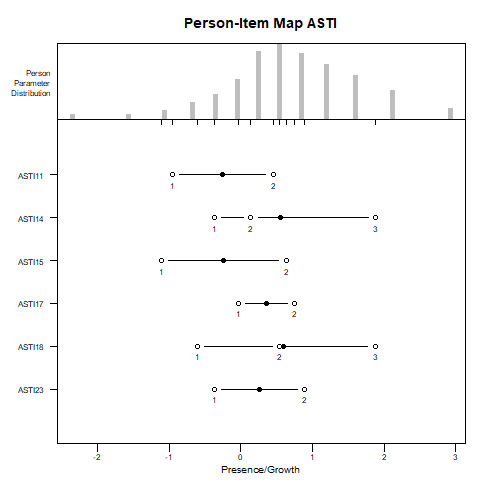
In contrast to the RSM, the PCM allows the distances between category thresholds to vary across items. This flexibility captures item-specific response structures more accurately, but it also introduces potential interpretive challenges.
Occasionally, the thresholds may appear to be “out of order” in the PI-map. For example, threshold 2 may appear lower than threshold 1. This does not indicate a model error, but rather that the response category associated with that threshold (e.g., category 2) is never the most probable category for any level of the latent trait.
To verify such cases, it is helpful to consult the ICCs. These plots show the probability of endorsing each response category across the trait continuum. If threshold 2 lies below threshold 1, and category 2’s curve is never the highest at any point on the latent trait, it confirms the interpretability issue.
Although no such irregularities appear in the current model, it is still useful to explore the ICCs using the command:
%%R
plotICC(fitpcm, item.subset = 5) # use item.subset = "all" to plot all items
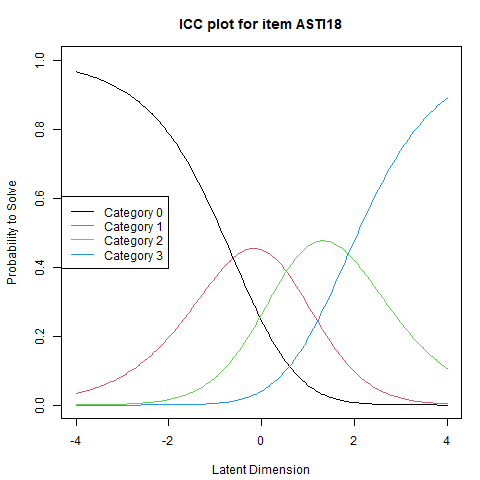
Test your understanding#
display_quiz("quiz/quiz_pcm.json")
5.3 Generalized Partial Credit Model#
The Generalized Partial Credit Model (GPCM), introduced by Muraki (1992), extends the Partial Credit Model by incorporating item-specific discrimination parameters (\(\\alpha_i\)). Similar to the 2-Parameter Logistic (2PL) model in binary IRT, these \(\\alpha_i\) parameters allow each item to vary in its discrimination power, resulting in ICCs with different slopes. This marks a key difference from the PCM, where discrimination is assumed to be equal across all items.
While the PCM is part of the Rasch model family—due to its fixed discrimination structure—the GPCM is not considered a Rasch model because it allows for free discrimination estimation. However, the PCM can be seen as a special case of the GPCM. In R, both models can be estimated using the ltm package via the gpcm() function. By setting constraint = "rasch" in this function, the model fixes all discrimination parameters to 1, effectively fitting a PCM.
The Dataset#
To illustrate the application of both PCM and GPCM, we return to the ASTI dataset. This time, we analyze the self-transcendence (ST) subscale, which consists of seven polytomous items. These data provide an ideal setting to examine whether allowing item discrimination to vary significantly improves model fit.
Load and inspect the dataset#
# Load the data in R
ro.r("data(ASTI)")
# Convert data to a Pandas df
ASTI = pandas2ri.rpy2py(ro.globalenv['ASTI'])
# Extract ST items
STitems = ASTI.iloc[:, [1,3,7,12,15,23,24]]
# Inspect the dataset
print(STitems.head())
# Put data back into R
ro.globalenv['STitems'] = STitems
ASTI2 ASTI4 ASTI8 ASTI13 ASTI16 ASTI24 ASTI25
1 2.0 3.0 1.0 2.0 3.0 0.0 2.0
2 2.0 2.0 1.0 2.0 2.0 1.0 1.0
3 1.0 1.0 2.0 2.0 1.0 1.0 2.0
4 2.0 3.0 2.0 2.0 3.0 0.0 1.0
5 3.0 3.0 1.0 2.0 3.0 1.0 0.0
Fit the model#
ro.r('stpcm <- gpcm(STitems, constraint = "rasch")') # Partial Credit Model
ro.r('stgpcm <- gpcm(STitems)') # Generalized Partial Credit Model
print(ro.r('summary(stpcm)'))
print(ro.r('summary(stgpcm)'))
Call:
gpcm(data = STitems, constraint = "rasch")
Model Summary:
log.Lik AIC BIC
-9203.121 18442.24 18532.76
Coefficients:
$ASTI2
value std.err z.value
Catgr.1 -1.391 0.113 -12.310
Catgr.2 -0.531 0.082 -6.492
Catgr.3 1.154 0.092 12.608
Dscrmn 1.000 NA NA
$ASTI4
value std.err z.value
Catgr.1 -1.758 0.125 -14.105
Catgr.2 -0.602 0.080 -7.520
Catgr.3 1.330 0.093 14.283
Dscrmn 1.000 NA NA
$ASTI8
value std.err z.value
Catgr.1 -0.863 0.081 -10.611
Catgr.2 0.925 0.083 11.138
Dscrmn 1.000 NA NA
$ASTI13
value std.err z.value
Catgr.1 -1.229 0.095 -12.877
Catgr.2 -0.001 0.075 -0.008
Dscrmn 1.000 NA NA
$ASTI16
value std.err z.value
Catgr.1 -1.474 0.108 -13.672
Catgr.2 -0.208 0.079 -2.627
Catgr.3 1.307 0.098 13.342
Dscrmn 1.000 NA NA
$ASTI24
value std.err z.value
Catgr.1 -0.546 0.077 -7.139
Catgr.2 1.327 0.092 14.464
Dscrmn 1.000 NA NA
$ASTI25
value std.err z.value
Catgr.1 -1.375 0.103 -13.400
Catgr.2 -0.073 0.079 -0.929
Catgr.3 1.472 0.104 14.196
Dscrmn 1.000 NA NA
Integration:
method: Gauss-Hermite
quadrature points: 21
Optimization:
Convergence: 0
max(|grad|): 0.011
optimizer: nlminb
Call:
gpcm(data = STitems)
Model Summary:
log.Lik AIC BIC
-9055.544 18161.09 18286.81
Coefficients:
$ASTI2
value std.err z.value
Catgr.1 -1.974 0.238 -8.304
Catgr.2 -0.803 0.158 -5.082
Catgr.3 1.675 0.211 7.955
Dscrmn 0.616 0.093 6.600
$ASTI4
value std.err z.value
Catgr.1 -2.987 0.417 -7.156
Catgr.2 -1.108 0.214 -5.180
Catgr.3 2.328 0.334 6.977
Dscrmn 0.483 0.077 6.260
$ASTI8
value std.err z.value
Catgr.1 -4.425 1.862 -2.376
Catgr.2 4.820 2.021 2.385
Dscrmn 0.142 0.059 2.395
$ASTI13
value std.err z.value
Catgr.1 -2.524 0.421 -6.002
Catgr.2 -0.198 0.188 -1.057
Dscrmn 0.377 0.065 5.802
$ASTI16
value std.err z.value
Catgr.1 -2.312 0.303 -7.628
Catgr.2 -0.337 0.143 -2.358
Catgr.3 2.057 0.274 7.519
Dscrmn 0.539 0.084 6.385
$ASTI24
value std.err z.value
Catgr.1 -0.721 0.119 -6.066
Catgr.2 1.783 0.220 8.102
Dscrmn 0.714 0.114 6.282
$ASTI25
value std.err z.value
Catgr.1 -1.665 0.182 -9.175
Catgr.2 -0.081 0.091 -0.896
Catgr.3 1.776 0.196 9.081
Dscrmn 0.864 0.154 5.595
Integration:
method: Gauss-Hermite
quadrature points: 21
Optimization:
Convergence: 0
max(|grad|): 0.073
optimizer: nlminb
# Likelihood Ratio Test (LRT) via anova()
print(ro.r('anova(stpcm, stgpcm)'))
Likelihood Ratio Table
AIC BIC log.Lik LRT df p.value
stpcm 18442.24 18532.76 -9203.12 18
stgpcm 18161.09 18286.81 -9055.54 295.15 25 <0.001
The table above presents the results from a Likelihood Ratio Test (LRT) comparing the fit of the PCM and GPCM.
Lower AIC and BIC values indicate a better-fitting model. In this case, the GPCM shows substantially lower AIC (18161.09 vs. 18442.24) and BIC (18286.81 vs. 18532.76) values compared to the PCM. This suggests that the GPCM offers a better balance between model fit and complexity.
The Likelihood Ratio Test statistic (LRT = 295.15, df = 25, p < .001) provides statistical support for this conclusion. The significant p-value indicates that the improvement in fit achieved by allowing item discrimination to vary (as in the GPCM) is unlikely to have occurred by chance.
Test |
Compares: |
Tests: |
Use case: |
|---|---|---|---|
|
Nested IRT models (ex. PCM vs GPCM) |
Model improvement (fit) |
Model selection |
|
Same model across subgroups |
Item parameter invariance |
Model fit across groups |
ICCs#
%%R
plot(stpcm, main = "ICC PCM", items = 1)
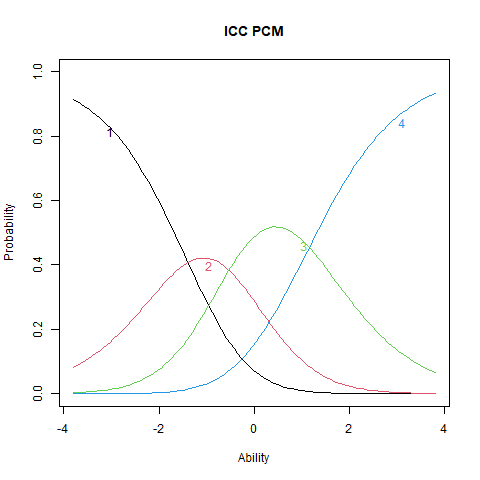
%%R
plot(stpcm, main = "ICC PCM", items = 2)
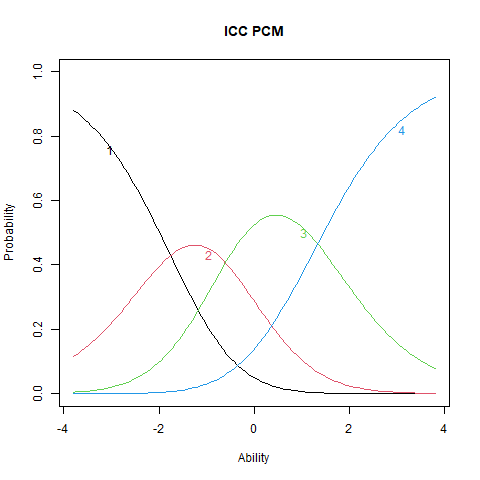
%%R
plot(stgpcm, main = "ICC GPCM", items = 1)
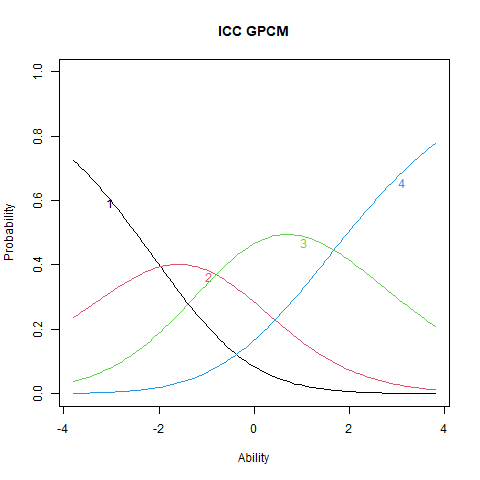
%%R
plot(stgpcm, main = "ICC GPCM", items = 2)
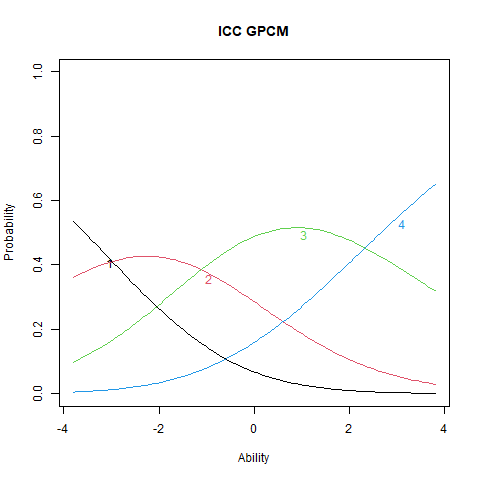
Interpreting ICCs in PCM vs. GPCM#
The ICC plots illustrate the structural differences between PCM and GPCM. The upper panels display ICCs for two items estimated under the PCM, where the slopes are constant both within and across items. Although the ICCs may appear visually similar, slight differences still emerge due to item-specific threshold locations. The lower panels show ICCs from the GPCM fit. Here, slopes vary across items, but remain constant within each item—this variation arises from the inclusion of item-specific discrimination parameters (\(\alpha_i\)).
Interpretation#
Items with higher \(\alpha_i\) values exhibit steeper ICCs, indicating greater sensitivity to differences in the latent trait. These items are more effective at distinguishing between individuals at different trait levels. Conversely, items with lower \(\alpha_i\) values produce flatter ICCs, reflecting weaker associations with the latent trait and reduced discriminatory power. Such items contribute less precise information about a person’s position on the trait continuum.
Test your understanding#
display_quiz("quiz/quiz_gpcm.json")

